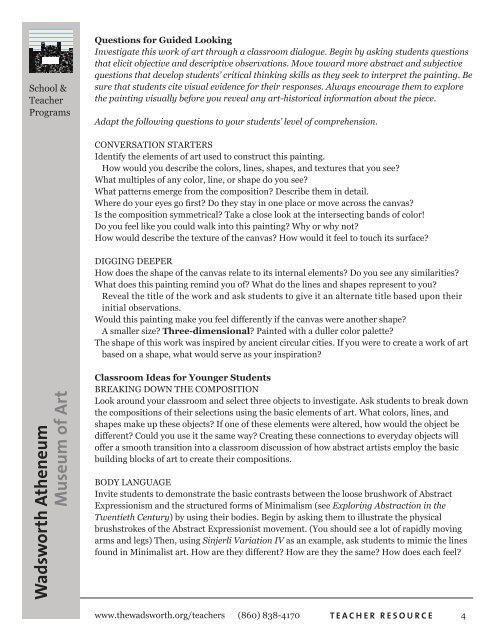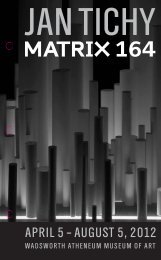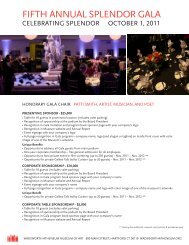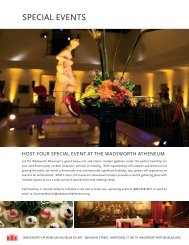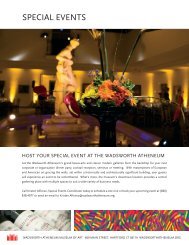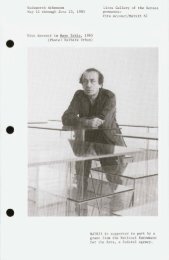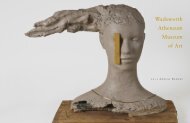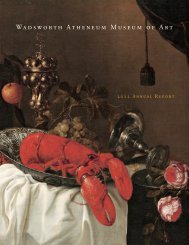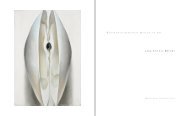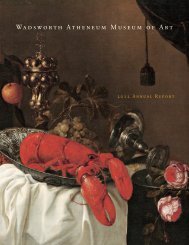Frank Stella - The Wadsworth Atheneum
Frank Stella - The Wadsworth Atheneum
Frank Stella - The Wadsworth Atheneum
Create successful ePaper yourself
Turn your PDF publications into a flip-book with our unique Google optimized e-Paper software.
School &<br />
Teacher<br />
Programs<br />
<strong>Wadsworth</strong> <strong>Atheneum</strong><br />
Museum of Art<br />
Questions for Guided Looking<br />
Investigate this work of art through a classroom dialogue. Begin by asking students questions<br />
that elicit objective and descriptive observations. Move toward more abstract and subjective<br />
questions that develop students’ critical thinking skills as they seek to interpret the painting. Be<br />
sure that students cite visual evidence for their responses. Always encourage them to explore<br />
the painting visually before you reveal any art-historical information about the piece.<br />
Adapt the following questions to your students’ level of comprehension.<br />
CONVERSATION STARTERS<br />
Identify the elements of art used to construct this painting.<br />
How would you describe the colors, lines, shapes, and textures that you see?<br />
What multiples of any color, line, or shape do you see?<br />
What patterns emerge from the composition? Describe them in detail.<br />
Where do your eyes go first? Do they stay in one place or move across the canvas?<br />
Is the composition symmetrical? Take a close look at the intersecting bands of color!<br />
Do you feel like you could walk into this painting? Why or why not?<br />
How would describe the texture of the canvas? How would it feel to touch its surface?<br />
DIGGING DEEPER<br />
How does the shape of the canvas relate to its internal elements? Do you see any similarities?<br />
What does this painting remind you of? What do the lines and shapes represent to you?<br />
Reveal the title of the work and ask students to give it an alternate title based upon their<br />
initial observations.<br />
Would this painting make you feel differently if the canvas were another shape?<br />
A smaller size? Three-dimensional? Painted with a duller color palette?<br />
<strong>The</strong> shape of this work was inspired by ancient circular cities. If you were to create a work of art<br />
based on a shape, what would serve as your inspiration?<br />
Classroom Ideas for Younger Students<br />
BREAKING DOWN THE COMPOSITION<br />
Look around your classroom and select three objects to investigate. Ask students to break down<br />
the compositions of their selections using the basic elements of art. What colors, lines, and<br />
shapes make up these objects? If one of these elements were altered, how would the object be<br />
different? Could you use it the same way? Creating these connections to everyday objects will<br />
offer a smooth transition into a classroom discussion of how abstract artists employ the basic<br />
building blocks of art to create their compositions.<br />
BODY LANGUAGE<br />
Invite students to demonstrate the basic contrasts between the loose brushwork of Abstract<br />
Expressionism and the structured forms of Minimalism (see Exploring Abstraction in the<br />
Twentieth Century) by using their bodies. Begin by asking them to illustrate the physical<br />
brushstrokes of the Abstract Expressionist movement. (You should see a lot of rapidly moving<br />
arms and legs) <strong>The</strong>n, using Sinjerli Variation IV as an example, ask students to mimic the lines<br />
found in Minimalist art. How are they different? How are they the same? How does each feel?<br />
www.thewadsworth.org/teachers (860) 838-4170 T E A C H E R R E S O U R C E<br />
4


